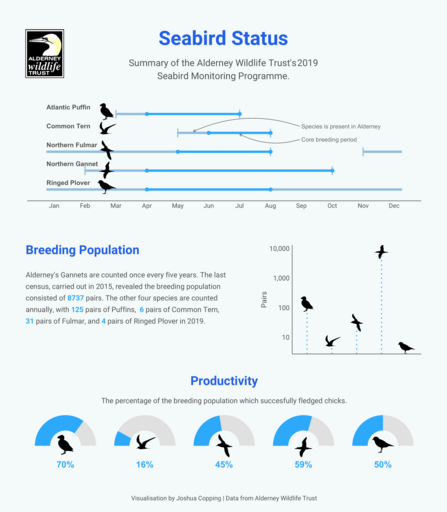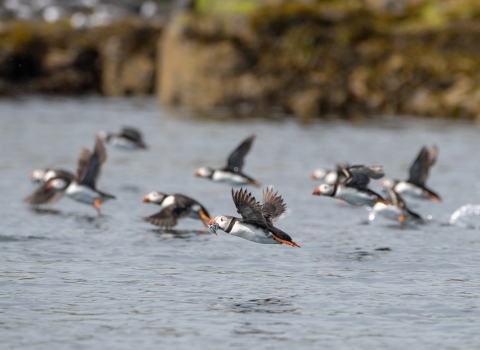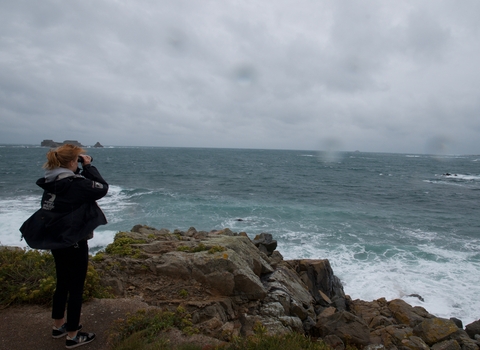Introduction
Alderney's Ramsar site was designated in 2005, becoming the first Ramsar site in the Bailiwick of Guernsey. Now it makes up one of eight Ramsar sites in the Channel Islands, details of which can be found on the Channel Island Ramsar Site website.
All Alderney Ramsar data are licensed under CC BY-NC,
Copyright rests with States of Alderney and contributing parties, queries for commercial use should be sent to ramsar@alderneywildlife.org
Using these data:
You must ensure that the appropriate citation is included in full in the reference list of any reports or publications that describe any research in which the data have been used.
Management Strategy Reviews
Seabird Summary
Why was this area designated as a Ramsar site?
The most northerly of the Channel Island Ramsar sites comprises the western coast of Alderney and nearby shallow waters and islets. This strongly tidal, high-energy area includes a diverse array of marine ecosystems, from sandy beaches with pebble and shingle banks, to rocky marine shores with intertidal pools, and coastal cliffs.
Designated in part because of the regionally, nationally and internationally important populations of seabirds. In particular, the islets of Ortac and Les Etacs support more than 1% of the world's population of Northern Gannets (Morus bassanus).
The rocky islands are not only important breeding sites for birds, they also provide an ideal habitat for grey seals to haul out, such as at the seal colony to the north of Burhou Island, and for fish and shellfish species such as lobsters, bass and plaice. In addition to the wild animals the site hosts about 100 species of seaweeds, which play a very important role in supporting all the marine wildlife.
There is a visitor center which provides both information and educational materials for children and the general public. Common visitor activities are birdwatching, walking and rock pooling over the summer months.
Alderney's Ramsar Management
In 2008 the Alderney Wildlife Trust (AWT), in collaboration with the Royal Society for the Protection of Birds, was asked by the States of Alderney (SoA) to prepare the Alderney Ramsar Strategy (ARS1). This process engaged both stakeholders and the general public over the course of several months and, upon its completion, the SoA's General Services Committee (GSC) asked the AWT to act as the Alderney Ramsar sites' Administrators, latterly referred to as the Ramsar Secretariat.
The AWT has fulfilled this role ever since on a voluntary basis, acknowledging the value of the site to not only its ecology, but also to the quality of life for residents and its benefits to tourism. This has been made possible thanks to a huge amount of work dedicated to the ARS by a large number of highly qualified volunteers.
As administrators the AWT helps the GSC by engaging with Activity Organisations involved in the site. The administrators also help prepare new ARS, as well as helping to develop, and report on, the Annual Action Plans (APS)through which the ARG is delivered.
The SoA maintains a Ramsar Budget to enable recovery of limited costs (not including staffing) from those organisation delivery works agreed under the APS.
In 2021 GSC formalised the Alderney Ramsar Advisory Group (ARAG). ARAG is and entirely voluntary group of environmental, veterinary and scientific experts from across the Channel Islands and UK who act on behalf of GSC. ARAG supports by reviewing proposed strategy and plans against the goals of the site and principles of the Ramsar convention, as well as assessing them against international best practice. ARAG operates under Terms of Reference set by the GSC.
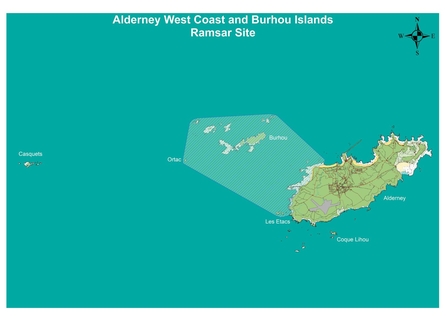
Since 2005 data has been collected on 10 seabird species for population size and productivity (success of raising a chick) rates and marine habitat mapping is carried out in new locations each year. The recording of this data is continued and expanded each year by the AWT in order to better understand the ecological processes of the Ramsar site and conserve its diversity within the convention guidelines.
All of the data gathered is not only used in the management of the Ramsar site but also in providing resources for the LIVE: Teaching through Nature interactive education project. You can watch the puffins on Burhou live from March - July when they are on the island on the LIVE website.
All the data we collect can be found in the latest reports on the Ramsar site which are downloadable in pdf format at the bottom of the page.
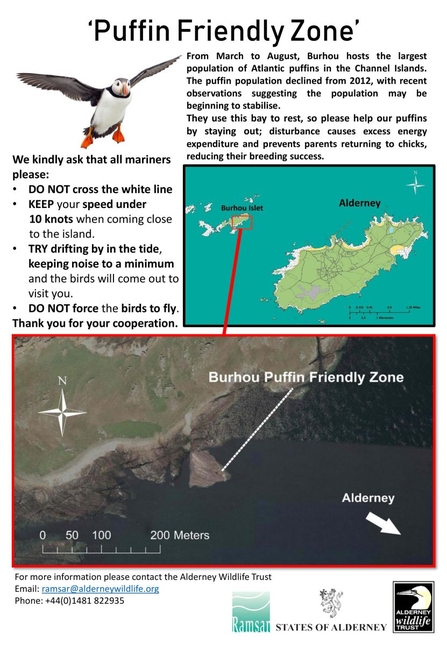
Puffin Friendly Zone
Following observations of a decline in Burhou’s puffin population and concerns of disturbance impacting breeding success the AWT, in collaboration with the States of Alderney, the Alderney Marine Management Forum, Alderney Harbour Office and local fishermen, designated a “Puffin Friendly Zone” in 2018. This zone, which is in place during the annual puffin breeding season, aims to provide the puffins with a safe area to rest, undisturbed by visiting or passing boats. Puffins are easily disturbed when rafting on the water, leading them to take flight which uses up vital energy reserves and interrupts feeding and parenting habits. This sort of disturbance can have a significant impact on breeding success.
We kindly ask all mariners to help protect puffins by following the associated code of conduct when near Burhou. Anyone can help by raising awareness of the Puffin Friendly Zone and helping to police it by informing the Alderney Harbour Office or the AWT if they see marine users within the zone.
The AWT monitors the puffins as part of the management of the Alderney Ramsar Site. The Puffin Friendly Zone represents a practical conservation response to the information gathered via monitoring, including the decline in the puffin population on Burhou between 2012 and 2017. Recent information suggests numbers may be beginning to stabilise, highlighting the importance of the Puffin Friendly Zone.
Atlantic puffins are currently listed by the International Union for Conservation of Nature (IUCN) as an endangered species in Europe, with rapid population declines likely due to threats including human disturbance, climate change, renewable energy production, pollution and shifting species distributions. Such threats, compounded with the species low breeding rates (1 chick per pair per year), makes puffins very sensitive species.
